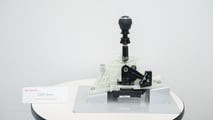The automotive world is rapidly transitioning to electric vehicles (EVs), but what happens to the beloved manual transmission? Toyota engineers are developing a groundbreaking solution: a Manual Electric Car. This innovative system aims to replicate the engaging driving experience of a traditional manual in an EV.
The Manual EV Concept: A Contradiction?
Most EVs utilize single-speed transmissions due to the inherent efficiency and torque delivery of electric motors. However, a team of Toyota engineers, led by Yoichiro Isami, believes the visceral connection and control of a manual gearbox shouldn’t be lost in the electric era. This prototype system uses sensors and software to simulate the feel of a manual transmission, complete with a clutch pedal and a six-speed shifter.
Simulating the Manual Experience in an Electric Car
The system works by employing sensors on the clutch pedal and gear shifter. These sensors detect the driver’s inputs and relay them to a software program that modulates the electric motor’s torque output, mimicking the behavior of a traditional manual transmission. Artificial engine noise piped through the car’s speakers further enhances the immersive experience.
Test Driving the Manual Electric Lexus UX
A Lexus UX 300e serves as the test mule for this innovative technology. The prototype features a custom six-speed gearbox that provides a tactile and engaging shifting experience. The simulated engine sounds and the car’s physical reactions to gear changes create a surprisingly realistic manual driving experience, blurring the lines between EV and internal combustion engine (ICE) vehicles.
The system even allows for stalling and restarting, mimicking the behavior of a manual gas car. The ability to engine brake and double-clutch further enhances the realism. The driver can switch between the simulated manual mode and the standard automatic EV mode at will.
The Future of the Manual Electric Car
While questions remain about its practical application and market viability, Toyota’s manual electric car demonstrates a commitment to preserving the joy of driving for enthusiasts. The system’s potential appeal lies in its ability to offer the best of both worlds: the engaging experience of a manual transmission and the efficiency and convenience of an EV. While the initial prototype utilizes a Lexus UX, future applications could extend to sports cars and other performance-oriented EVs.
This innovation highlights a broader trend within Toyota to inject more excitement into electric vehicles. Experiments with customizable engine sounds and driving profiles suggest a future where EVs can cater to a wider range of driving preferences. Whether this technology becomes a mainstream feature or a niche offering for enthusiasts remains to be seen. However, the manual electric car represents a bold step towards a future where EVs can be both sustainable and exhilarating.
Conclusion
The development of a manual electric car by Toyota signals a potential shift in the EV landscape. By blending the engaging driving dynamics of a manual transmission with the efficiency of an electric powertrain, Toyota aims to cater to driving enthusiasts who crave a more connected and interactive experience. This innovation could pave the way for a future where electric cars are not just environmentally friendly but also genuinely fun to drive.


